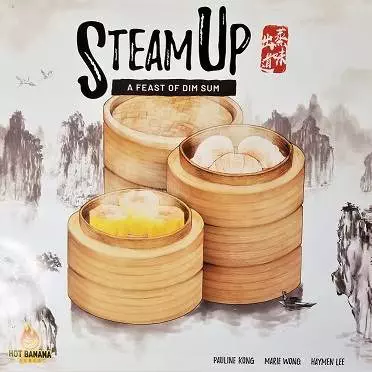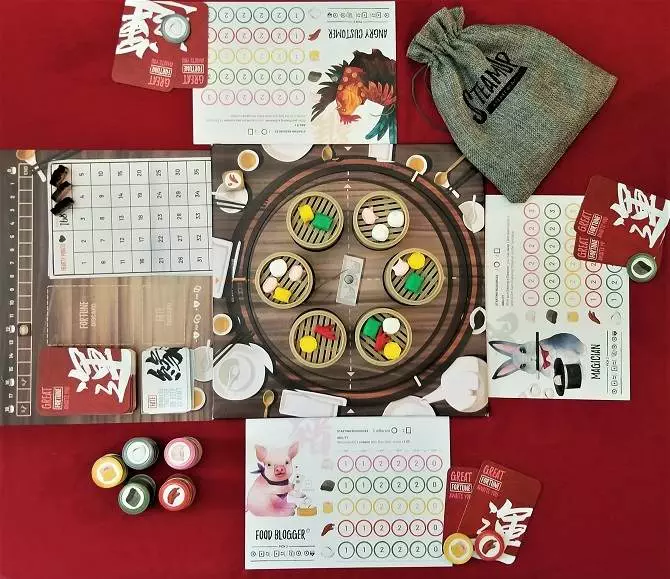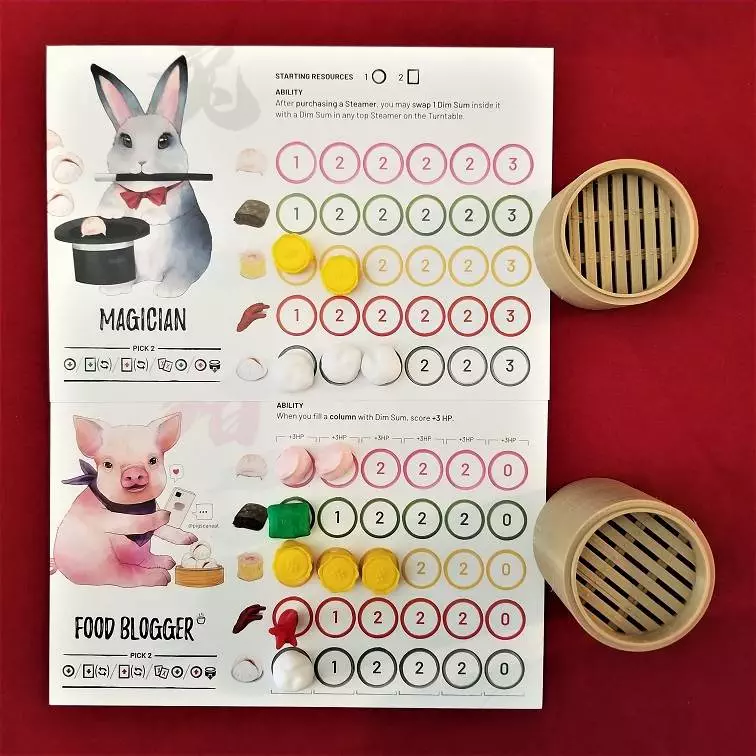
As we say in the restaurant, “hot food coming through!” or, in this case, “hot game coming through!” Set in a mythical restaurant, Steam Up: A Feast of Dim Sum is a tasty twist on the set collection genre while adding some mythological and astrological flavor. Chinese Zodiac myths and legends are woven seamlessly into the game’s theme as players take up the role of the animals dining at the table and sharing a quick meal of dim sum. As the steamers are emptied, players will discern if having a varied or narrow palate will aid them in their scoring as strategies are formed and changed by both fate and fortune.
Steam Up is designed by the Hot Banana Games team of Marie Wong, Haymen Lee, and Pauline Kong. The game features artwork from YDX Art, Tim Cheng, and Grace Tjahyadi. Steam Up is the debut game for both the design and illustration teams, but we here at the Cardboard Cantina are hoping to see more of their works. For this Kickstarter preview, we borrowed a prototype copy of the game and many of the stretch goals for the Kickstarter campaign were met long before it reached us in the review chain so the components featured in the photos herein will not match the final product in quality or quantity. As of this publication, there are only a few short days left of the campaign!
Once you’ve played a game or two of Steam Up, setup becomes really easy to figure out. The first time, however, can seem a little daunting with how many components are involved. To begin, players first need to set the Turntable and Scoreboard in the middle of the table. The Feast Zone Indicator ring for the game is determined by how many players there are and is easily identifiable thanks to the dots near the orange line. The inner platform of the Turntable should be rotated so all four of the arrows line up with the four arrows on the outer edge of the board. Either the players or the board needs to be positioned in such a way that the players are facing their individual “feast zone.” The Steamers will need to be separated, filled, shuffled, and stacked randomly in sets of three per the instructions in the rulebook before placing one stack in each of the six slots on the Turntable. Each player is then handed two Animal Boards at random and gets to choose who they wish to play as. Each animal is based on the Chinese Zodiac and comes with its own unique ability and starting resources. Once the player has decided which animal they will play as, they will also receive their starting fortune cards, food tokens, and matching scoring marker. The score markers are placed on the “VIP Guests” space on the Scoreboard. Additionally, the Scoreboard holds the shuffled deck of red Fortune cards, the shuffled eighteen Fate cards, and the Steamer counter on its designated Steamer track. All remaining Fate cards are returned to the box and are not used in the current game. The remaining food tokens, bag of dim sum pieces, and lucky die are all placed within easy reach of the players. A random player is chosen to receive the Chili Oil first player marker and to begin the game.
When boiled down, Steam Up is incredibly simple: players take turns trying to buy Steamers in order to collect sets of dim sum pieces while competing to earn the most points at the end of the game. However, the game actually has a lot more to it than originally meets the eye. For example, the board itself is constantly moving and changing and so are the dim sum offerings. There is also more than one type of set collection going on as players not only need to collect sets of dim sum to score points, but they also need to collect sets of tokens before they can buy the Steamers containing the dim sum! In each round, players will each take a turn during which they will perform two actions out of the five available to choose from. Actions include things like gaining food tokens, drawing or playing cards with the opportunity to rotate the Turntable, or purchasing a Steamer. After all of the players have had their turn, a Fate card is flipped. These cards can either help or hinder the players; sometimes causing drastic changes to one’s strategy after several turns of planning! As Steamers are purchased, the Steamer Counter is moved further down the track until it reaches 0, signaling the end of the game. Should the Fate deck empty before the Steam Counter reaches 0, the game also comes to an end. In addition to the points earned during the game, players will receive additional points for every two Fortune cards remaining in their hands and will lose points for every two unspent food tokens. The player with the highest score wins.
Steam Up is a fresh 2-5 player game that is chock-full of innovative components and well-thought-out design elements that combine for a perfectly plated presentation to be set before the consumer. After several plays at multiple player counts, we’ve come to realize that Steam Up will have a very long shelf life in our home and have decided to back it for ourselves. We are torn on whether we prefer the 3D components over the cardboard tokens as it makes “random” draws a little more difficult to keep truly random when one can easily tell what shaped piece they are “blindly” grabbing from the bag, but we do like the added immersion and table presence the upgrade brings with it so we will have to wait and see how we feel about the final product. The game itself plays surprisingly quickly and was really easy to learn, play, and teach to others. We found early on that having a voracious appetite and rushing through the Steamers may not be the best of strategies, but trying to hold out for bigger scores may also not be as beneficial as one might think. With the use of the Fortune and Fate cards, the board, player order, and visible Steamers were almost constantly in flux so we often found our strategies changing on the fly. Being used to the restaurant environment, we found ourselves quite at home with this unexpected development, but some of our non-food service gamer friends found themselves a bit in the weeds trying to balance all of the rapid changes while avoiding analysis paralysis. All in all, we had an excellent time, were a bit sad to send the prototype on, but are looking forward to when our own Kickstarter rewards will arrive.
All photos of Hot Banana Games products were taken and edited by Krista.

